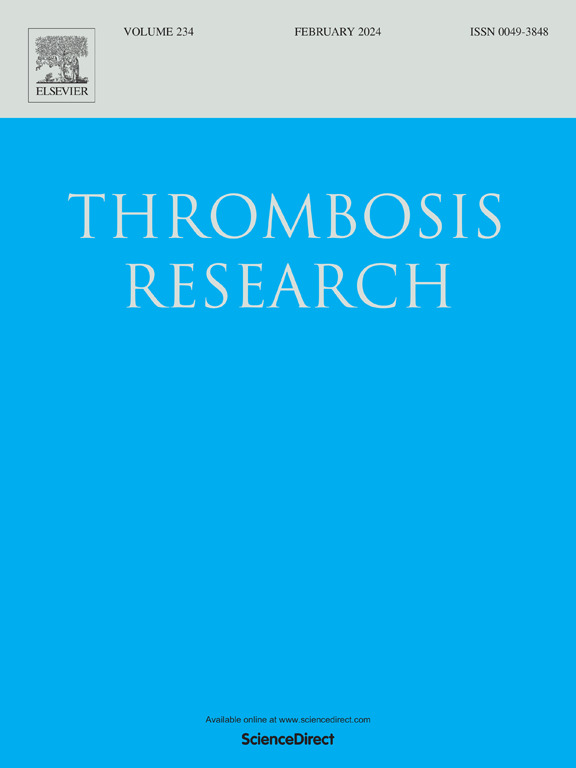HemoDens: A global hemostasis analyzer for kinetic characterization of clot formation, retraction, and lysis
IF 3.4
3区 医学
Q1 HEMATOLOGY
引用次数: 0
Abstract
During clot retraction (CR), platelets use their actomyosin apparatus to contract the cross-linked fibrin-platelet meshwork of a nascent thrombus. As CR depends on thrombin generation, fibrin polymerization/cross-linking, platelet activation and fibrinolysis, measurements of CR can provide valuable information about global hemostatic function. However, a lack of standardized methods for simple and reproducible assessment of CR remains a major obstacle to a more widespread adoption of CR assays for clinical testing. Herein, we developed a whole-blood hemostasis analyzer (HemoDens) to enable rapid and reproducible kinetic characterization of clot formation (CF), CR, and exogenous clot lysis (eCL) from minute quantities of citrated whole blood. In our assay, double-end-anchored clots were formed inside hemitoroidal fluoropolymer sample chambers. This approach provided spatiotemporal standardization by focusing macroscale contractile forces on a geometrically defined region-of-interest (ROI) from which clots retracted uniformly. Fluorescence densitometry was used to monitor the redistribution of RBCs in this ROI during experiments. A set of analytical parameters provided a detailed kinetic characterization of CF, CR and eCL from a single experiment. The specific effects of CR on our assay were verified experimentally by inhibiting platelet fibrin(ogen) binding, actin polymerization, and non-muscle myosin II. We verified the sensitivity of our assay to variations in blood counts, and to the effects of unfractionated heparin (UFH), low molecular weight heparin (LMWH), dabigatran, and recombinant tissue plasminogen activator (rtPA). We also show that our assay could detect the reversal of heparins and rtPA with protamine and tranexamic acid.

haemdens:用于血块形成、缩回和溶解动力学表征的全球止血分析仪
在凝块缩回(CR)过程中,血小板使用它们的肌动球蛋白装置来收缩新生血栓的交联纤维蛋白-血小板网。由于CR依赖于凝血酶生成、纤维蛋白聚合/交联、血小板活化和纤维蛋白溶解,因此CR的测量可以提供有关整体止血功能的有价值信息。然而,缺乏简单和可重复评估CR的标准化方法仍然是更广泛采用CR测定法进行临床检测的主要障碍。在此,我们开发了一种全血止血分析仪(haemdens),能够从微量柠檬酸全血中快速、可重复地表征凝块形成(CF)、CR和外源性凝块溶解(eCL)。在我们的实验中,双端锚定凝块在半环形含氟聚合物样品腔内形成。这种方法通过将宏观收缩力集中在几何定义的兴趣区域(ROI)上,从而提供了时空标准化,凝块从该区域均匀收缩。在实验期间,荧光密度测定法用于监测红细胞在该ROI中的再分布。一组分析参数提供了CF、CR和eCL的详细动力学表征。通过抑制血小板纤维蛋白(原)结合、肌动蛋白聚合和非肌球蛋白II,实验验证了CR对我们实验的特异性作用。我们验证了我们的检测方法对血细胞计数变化的敏感性,以及对未分离肝素(UFH)、低分子量肝素(LMWH)、达比加群和重组组织型纤溶酶原激活剂(rtPA)的影响。我们还发现我们的方法可以检测到鱼精蛋白和氨甲环酸对肝素和rtPA的逆转作用。
本文章由计算机程序翻译,如有差异,请以英文原文为准。
求助全文
约1分钟内获得全文
求助全文
来源期刊

Thrombosis research
医学-外周血管病
CiteScore
14.60
自引率
4.00%
发文量
364
审稿时长
31 days
期刊介绍:
Thrombosis Research is an international journal dedicated to the swift dissemination of new information on thrombosis, hemostasis, and vascular biology, aimed at advancing both science and clinical care. The journal publishes peer-reviewed original research, reviews, editorials, opinions, and critiques, covering both basic and clinical studies. Priority is given to research that promises novel approaches in the diagnosis, therapy, prognosis, and prevention of thrombotic and hemorrhagic diseases.
 求助内容:
求助内容: 应助结果提醒方式:
应助结果提醒方式:


